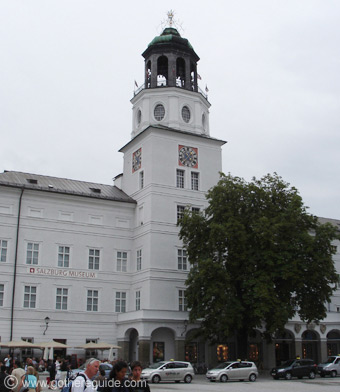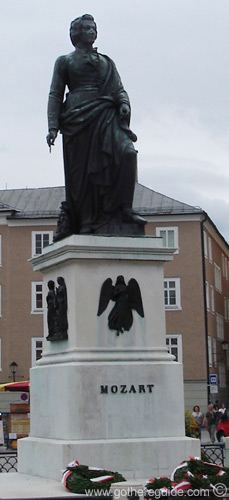
Glockenspiel - Glockenspiel information and pictures
| Tweet |
The 35 bells of the tower were bought by Archbishop Johann Ernst Graf Thun in 1695. He wanted to eternalize his name by financing the purchase of the bells. The bells themselves were created by Melchior de Haze in 1696. The bass drum and the drive mechanism were made by Benedikt Eisenberger and Franz Sulzer. The carillon was brought from Belgium and is a latter addition to the New Residence. While the bells were delivered in 1700, the Flemish Glockenspiel technology was not favored by the residents of the city. It took 2 years before the clockmaker Jeremias Sauter arranged the bells in the correct order.
The clock mechanism that releases music was installed in 1873 by Johann Baptist Fischer. The mechanism still exists, but an electronic timer starts the music at 7 am, 11 am, and 6 pm. The bass drum was also equipped with an electronic motor several decades ago.
The Glockenspiel has played music since 1704, and 16 out of the 40 pieces were written by Johann Haydn. Other pieces are written by the Mozarts and are 19th-century adaptations. The pieces played change on a monthly basis. Some examples are Stille Nacht by Gruber, Glockenspiel, die Zauberflöte by Mozart, Menuett and Mailied by Mozart, and Tochter Zion by Händel.
A 200-pipe organ plays music following the bells’ performance. It is the world’s oldest mechanical instrument found in the Hohensalzburg Fortress. Information about the musical selection is presented on a notice board at the corner of the Neue Residenz.
The clock contains three elements: a drum and barrel, clockwork, and bells. The smallest bell weighs just 16 kg and the largest one – 380 kg. The chime mechanism weighs several tons and is comprised of 3,500 components taking 5 floors. The restoration works were completed in 2011, and the process took 2 years, costing 400,000 Euros.
Tourists can opt for a guided tour on Thursday and Friday from March to October and can have a close look at the bells and clockwork. Tours are available for small groups. The Panorama museum is the meeting point for guided tours. Alternatively, tourists can have a coffee at the Café Demel and enjoy the music played by the Glockenspiel. Café Glockenspiel is another place to listen to the music played by the bells and is a popular meeting place for the city’s residents.
Where is Glockenspiel: Mozartplatz 1, Salzburg Museum

Glockenspiel, Salzburg

Mozart Monument, Salzburg
Please help us build a better site. Add your comments about Glockenspiel here.

Salzburg Attractions
Copyright © GoThereGuide.com 2015
All rights reserved.
All rights reserved.
User Comments about Glockenspiel